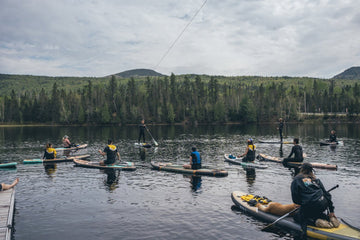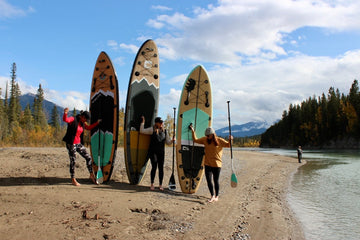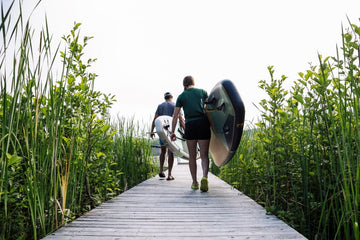Selecting the appropriate length for your paddle board is crucial to ensure an enjoyable and efficient paddling experience. Factors such as your weight, intended usage, and the type of water you'll be paddling in all play a role in determining the optimal length. Let's delve into how these factors influence your choice and how length and width impact stability and speed:
Weight Considerations:
Shop smaller paddle boards here

Usage Intentions:
Recreational Paddling: For casual paddlers looking to enjoy relaxing sessions on flat water, a mid-length board (typically 10-12 feet) strikes a balance between stability and maneuverability.
Touring or Racing: If you're into touring or racing, longer boards (12-14 feet or more) are preferable. Their increased length enhances speed and efficiency, making them suitable for covering longer distances with less effort.
Water Type:
Calm Water (Lakes, Ponds): In calm conditions, shorter boards can suffice as they are easier to control and maneuver. However, if stability is a priority, especially for beginners, consider a wider board for added balance.
Open Water (Ocean, Rivers): In more dynamic water environments with waves or currents, longer boards excel. Their increased length helps cut through waves and maintain stability, while a narrower width can improve speed and tracking.
White Water: For paddling in white water, which involves navigating through turbulent and rapid-filled sections of rivers, shorter and more maneuverable boards are preferred. A shorter length (around 8-10 feet) allows for quick turns and better control in fast-moving water.

Impact of Length and Width on Stability and Speed:
Stability: Longer and wider boards generally offer better stability, making them suitable for beginners, heavier paddlers, and activities where balance is crucial, such as yoga or fishing.
Speed: Longer boards have a longer waterline, allowing them to glide more efficiently and achieve higher speeds with less effort. However, narrower boards can also enhance speed due to reduced drag, especially in flat water conditions.
In summary, when choosing the length of your paddle board, consider your weight, intended usage (recreational, touring, racing), and the type of water you'll be paddling in, including white water for adventurous paddlers.
Longer boards provide better stability and speed, making them ideal for open water and touring, while shorter boards offer increased maneuverability and responsiveness, suitable for recreational paddling, calm waters, and white water adventures.
Additionally, pay attention to the width of the board, as wider boards enhance stability but may sacrifice some speed. By understanding how length and width impact stability and speed, you can make an informed decision and maximize your enjoyment on the water, no matter the conditions.
Happy paddling! 🏄



